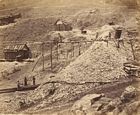- Alternative Names
- Swiss-Italians
There was no Italian nation prior to 1860. The first ‘Italians’ who arrived at the Victorian goldfields in the mid 1850s were mostly ethnic Lombards from the Italian speaking Ticino and Grisons cantons of Southern Switzerland. Some were also from the Sondrio, Como and Bergamo provinces of the northern Italian region of Lombardy. Although separated by national borders, the Swiss and Italian groups shared a common dialect, social practices and cultural affinity. They were often related, had intermarried, and for centuries had crossed the border for work and trade. A small number of Italians also migrated from Tuscany, Genoa and Sicily.
Both Swiss-Italian and Italian groups came from districts of endemic rural poverty which traditionally had forced the men of their communities to work away from home for eight to nine months of each year. Family survival depended on their seasonal or temporary migrations to other parts of Europe and then later, to the Californian and Victorian goldfields. The situation worsened in the 1850s following political upheavals in Italy and disastrous agricultural seasons.
German shipping companies, eager to find travellers for their Australian route, aggressively promoted the Victorian goldfields as immigration destinations. Swiss records from the Ticino canton show that, in an attempt to ease the poverty cycle, local communes encouraged their men to emigrate and lent them money to do so. These men were sojourners and it was understood that they would be away for only several years. This was the case with most of the 2,500 ticinesi who migrated to Victoria in the eighteen months between 1855-7; 65% of them returned home permanently within a short time. However, for others, circumstances, often outside their control, prevented their return.
There are said to have been about 6,000 Italians in Victoria by 1860, a figure which is difficult to verify as it is not clear whether Swiss-Italians were included. Italian speakers were to be found throughout the goldfields and the Bendigo, Castlemaine and Jim Crow diggings were early magnets. Well travelled routes developed between home and the goldfields and the first arrivals were followed by kin and compatriots. They tended to cluster together, providing economic and social support to one another.
In the 1860s, there were more Italian nationals than Swiss-Italians arriving in the colony. New arrivals sought out the emerging goldfields at Walhalla, Ararat, Stawell and other diggings. With the decline of alluvial gold yields and the widespread growth of deep lead or quartz mining, many Italian speakers, lacking capital and mining skills, took up other gold mining related occupations. They diversified and pooled their resources to become cartage contractors, wood tramway builders and operators, woodcutters and charcoal burners, rather than miners.
Daylesford and Hepburn districts became centres for Swiss-Italian and Italian settlement. Many settled as farmers, while others became brewers, hoteliers, pasta makers, builders and shopkeepers. Early mining settlements did not have a stable or entrenched society; they were more open-ended and tolerant of minority groups (other than the Chinese) than later settled Victorian communities. Most Italian speakers became part of local society’s fabric and makeup and introduced new ideas, practices and styles. In places like Hepburn and Daylesford, their legacy survives in the local stone architecture.
Following the Charters Towers gold discoveries in 1872, many Italians went to Queensland to try their luck. In the 1890s, they also travelled to the Western Australian goldfields and worked extensively on the Kalgoorlie wood lines.




